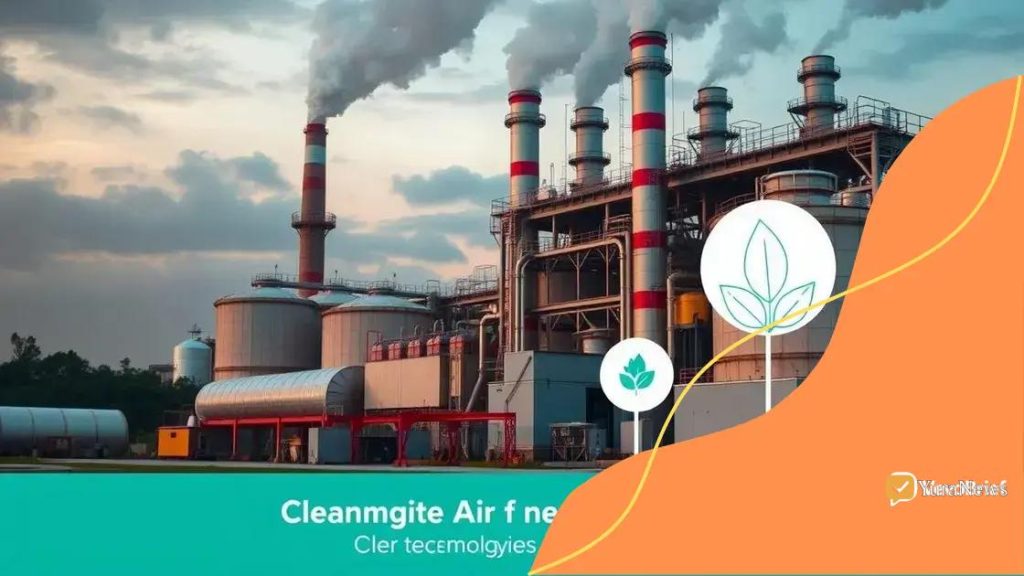EPA announces stricter environmental regulations impacting businesses

Anúncios
EPA announces stricter environmental regulations requiring businesses to reduce emissions and adopt sustainable practices that enhance compliance, improve brand image, and promote environmental responsibility.
EPA announces stricter environmental regulations that may catch many businesses off guard. Are you ready to navigate this new landscape? In this article, we’ll unpack the implications and how businesses can adapt effectively.
Anúncios
Overview of new EPA regulations
With the recent updates from the EPA, there are significant changes coming that everyone should know. These new regulations will impact a wide range of industries, making compliance essential. Let’s explore what these new rules entail.
Key Changes in Regulations
The EPA has introduced stricter standards aimed at reducing pollution and promoting sustainability. Businesses will need to adapt to these new codes to remain compliant and responsible. This may involve changes in reporting and accountability for emissions.
Areas Affected
Almost every sector will feel the effects of these regulations, including:
Anúncios
- Manufacturing industries
- Construction and demolition
- Transportation and logistics
- Agriculture
Each of these sectors may need to implement new technologies or practices to meet the EPA‘s expectations, focusing more on environmental protection and less on short-term profits.
In addition to stricter emissions standards, new reporting requirements aim to increase transparency. Businesses will now have to document their practices and demonstrate their commitment to sustainability. The EPA’s goal is to foster eco-friendly practices while holding companies accountable.
Implications for Compliance
Companies must start reviewing their processes now to identify necessary adjustments. This proactive approach will not only ensure compliance but can also enhance their brand image as environmentally conscious.
Staying informed and adapting promptly to the new regulations can place companies ahead of their competitors. Merely meeting the minimum requirements can no longer suffice; businesses will be expected to go above and beyond.
Remember, navigating these regulations effectively requires understanding not only your responsibilities but also the potential benefits of being an eco-friendly leader in your industry.
Impact on different industries
The EPA’s new regulations will have varied impacts across different industries. Understanding how these changes affect each sector is essential for businesses to adapt effectively. Let’s dive into the implications for some major areas.
Manufacturing Industry
In the manufacturing sector, companies will face tighter restrictions on emissions and waste management. This means investing in cleaner technologies and processes. The aim is to minimize environmental footprint while maintaining productivity.
- Increased emissions reporting
- Implementation of energy-efficient machinery
- Adoption of sustainable materials
- Enhanced employee training on environmental practices
These changes may require upfront investment, but they can lead to long-term savings and improved public perception.
Construction Sector
The construction industry will also feel the effects, particularly concerning building materials and waste disposal. Projects will need to incorporate sustainable practices. This involves sourcing recycled materials and using eco-friendly construction methods to comply with new regulations.
Moreover, stricter waste management protocols will be essential. By prioritizing recycling and responsible disposal, construction companies can significantly reduce their environmental impact.
Agriculture and Food Production
Agriculture is another critical area where the EPA’s regulations will lead to changes. Farmers will need to adopt better practices to manage fertilizer and pesticide use. Enhanced regulations will promote organic farming and reduce chemical runoff.
This shift is not just a compliance matter; it also opens opportunities for farmers to connect with health-conscious consumers who prefer organic produce.
As regulations evolve, it is crucial for each industry to proactively reassess their practices. By doing so, businesses can not only meet compliance standards but also benefit from improved sustainability and potentially lower operational costs in the long run.
Compliance strategies for businesses

As the EPA introduces new regulations, businesses must develop effective compliance strategies to navigate these changes successfully. Understanding what is required can help companies avoid penalties and position themselves as responsible entities.
Assess Current Practices
The first step in compliance is to thoroughly assess current operations. Companies should evaluate their existing processes to identify areas needing improvement. By doing this, businesses can determine what adjustments are necessary to meet the new regulations.
- Conduct an environmental audit
- Identify gaps in current compliance
- Evaluate waste management practices
- Review emissions data
Identifying these gaps is crucial for developing a robust compliance plan.
Invest in Technology
Investing in technology can be a game changer for compliance. By adopting advanced systems, businesses can enhance their ability to monitor and report on emissions or waste outputs. Technologies such as automated monitoring tools can provide real-time data, allowing companies to respond quickly to any issues.
In addition, technology can help with:
- Data collection and analysis
- Predictive modeling for emissions control
- Aiding in reporting requirements
- Improving resource efficiency
Integrating these technologies fosters a proactive approach to compliance.
Develop a Compliance Team
Creating a dedicated compliance team is essential for maintaining ongoing adherence to EPA regulations. This team should be responsible for monitoring compliance, managing documentation, and staying updated on any regulatory changes. Assigning specific roles ensures that compliance is taken seriously and integrated into the company culture.
Training employees on compliance practices is also crucial. By ensuring that everyone understands their role in maintaining standards, companies can foster a culture of accountability.
Finally, staying informed about upcoming regulations and changes in the compliance landscape is vital. Regular training sessions and updates can prepare the team to tackle new challenges confidently.
Benefits of meeting these regulations
Meeting the new EPA regulations brings numerous benefits for businesses that go beyond mere compliance. These advantages not only improve environmental standing but can also enhance overall business operations and reputation.
Enhancing Brand Reputation
One significant benefit of compliance is the positive impact on brand image. Companies that demonstrate a commitment to environmental responsibility are often viewed more favorably by consumers.
- Increased customer loyalty
- Positive media coverage
- Attracting environmentally conscious consumers
- Strengthened community relations
Building a reputation as an environmentally friendly business can help differentiate a brand in a competitive market.
Cost Savings and Efficiency
Adhering to EPA regulations can also lead to significant cost savings. By investing in cleaner technologies and practices, companies can reduce waste and improve efficiency.
For example, implementing energy-efficient systems can lower utility bills and operational costs. Over time, these savings can offset the initial compliance investments, making it a wise financial decision.
Access to Incentives and Grants
Many governments and organizations offer incentives for businesses that comply with environmental regulations. Companies that position themselves correctly can access grants, tax breaks, or subsidies aimed at promoting sustainability.
Leveraging these opportunities can alleviate some financial burdens associated with compliance while supporting further environmental initiatives.
Ultimately, compliance with EPA regulations not only fulfills legal obligations but also creates pathways for innovation and leadership in environmental responsibility. By embracing these changes, businesses can thrive while contributing positively to the planet.
Future outlook on environmental policies
The future of environmental policies is likely to become more stringent as global awareness of climate change continues to grow. Governments and organizations are recognizing the need for immediate action to protect our planet.
Increased Regulatory Measures
In the coming years, we can expect to see an increase in regulatory measures aimed at reducing emissions and promoting sustainability. Laws may evolve to further limit pollution from various industries, pushing companies to implement cleaner technologies more aggressively.
- New emissions reduction targets
- Stricter penalties for non-compliance
- Expanded monitoring and reporting requirements
- Encouragement for renewable energy adoption
As regulations tighten, businesses will need to be prepared to adapt their operations accordingly.
Global Cooperation and Agreements
Moreover, global cooperation will likely play a critical role in shaping future policies. International agreements, such as the Paris Agreement, emphasize the importance of collective action in addressing climate change.
This may lead to
- More countries committing to environmental goals
- Increased funding for green initiatives
- Sharing of technology and best practices
Collaboration on a global scale is essential to tackle issues that cross national borders.
Emphasis on Innovation
Innovation will be key to meeting future environmental challenges. As businesses seek to comply with stricter regulations, they may invest more in research and development to create sustainable solutions.
This could include developing:
- Alternative energy sources
- Waste reduction technologies
- Eco-friendly manufacturing processes
- Green transportation options
As technology advances, businesses that embrace sustainability will likely lead the way.
Overall, the future outlook on environmental policies suggests that businesses and governments must remain proactive. By forecasting these trends, companies can position themselves effectively and contribute positively to environmental protection.
As we look ahead, the importance of complying with EPA regulations cannot be overstated. Businesses that embrace these changes will not only enhance their brand image but also create opportunities for cost savings and innovation. By effectively adapting to the evolving landscape of environmental policies, companies can play a crucial role in promoting sustainability and protecting our planet. The future is not just about compliance; it’s about leading the way in environmental responsibility.
FAQ – Frequently Asked Questions about EPA Regulations and Compliance
What are EPA regulations?
EPA regulations are rules set by the Environmental Protection Agency to control pollution and protect the environment.
How can my business benefit from complying with EPA regulations?
Complying with EPA regulations can enhance your brand image, reduce costs, and provide access to government incentives.
What steps should I take to ensure compliance?
Start by assessing your current practices, investing in technology, and forming a compliance team to monitor ongoing requirements.
Why is environmental responsibility important for businesses?
Environmental responsibility is vital as it promotes sustainability, improves public perception, and helps ensure a healthy planet for future generations.